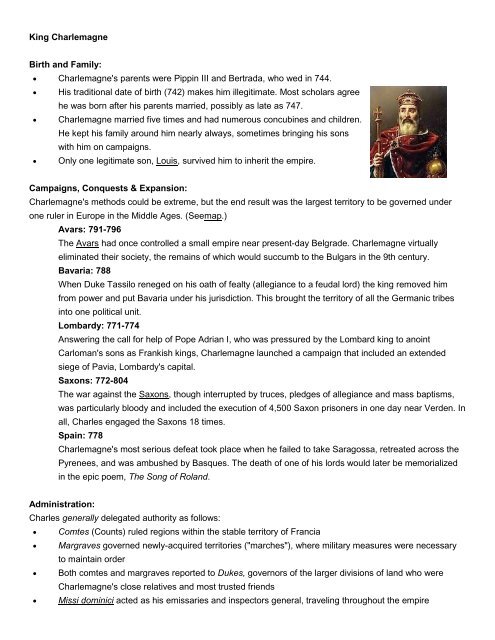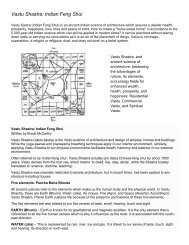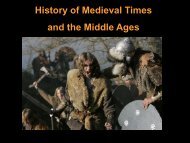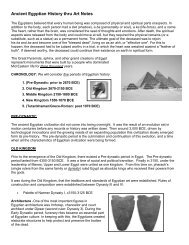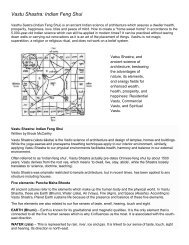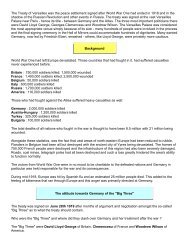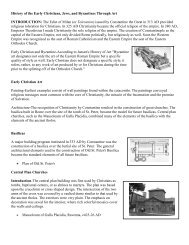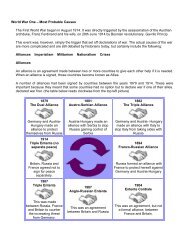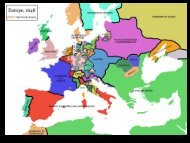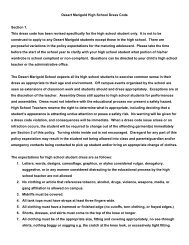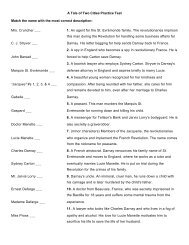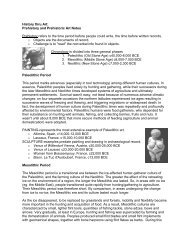King Charlemagne.pdf - DMHScommunity
King Charlemagne.pdf - DMHScommunity
King Charlemagne.pdf - DMHScommunity
Create successful ePaper yourself
Turn your PDF publications into a flip-book with our unique Google optimized e-Paper software.
<strong>King</strong> <strong>Charlemagne</strong>Birth and Family: <strong>Charlemagne</strong>'s parents were Pippin III and Bertrada, who wed in 744. His traditional date of birth (742) makes him illegitimate. Most scholars agreehe was born after his parents married, possibly as late as 747. <strong>Charlemagne</strong> married five times and had numerous concubines and children.He kept his family around him nearly always, sometimes bringing his sonswith him on campaigns. Only one legitimate son, Louis, survived him to inherit the empire.Campaigns, Conquests & Expansion:<strong>Charlemagne</strong>'s methods could be extreme, but the end result was the largest territory to be governed underone ruler in Europe in the Middle Ages. (Seemap.)Avars: 791-796The Avars had once controlled a small empire near present-day Belgrade. <strong>Charlemagne</strong> virtuallyeliminated their society, the remains of which would succumb to the Bulgars in the 9th century.Bavaria: 788When Duke Tassilo reneged on his oath of fealty (allegiance to a feudal lord) the king removed himfrom power and put Bavaria under his jurisdiction. This brought the territory of all the Germanic tribesinto one political unit.Lombardy: 771-774Answering the call for help of Pope Adrian I, who was pressured by the Lombard king to anointCarloman's sons as Frankish kings, <strong>Charlemagne</strong> launched a campaign that included an extendedsiege of Pavia, Lombardy's capital.Saxons: 772-804The war against the Saxons, though interrupted by truces, pledges of allegiance and mass baptisms,was particularly bloody and included the execution of 4,500 Saxon prisoners in one day near Verden. Inall, Charles engaged the Saxons 18 times.Spain: 778<strong>Charlemagne</strong>'s most serious defeat took place when he failed to take Saragossa, retreated across thePyrenees, and was ambushed by Basques. The death of one of his lords would later be memorializedin the epic poem, The Song of Roland.Administration:Charles generally delegated authority as follows: Comtes (Counts) ruled regions within the stable territory of Francia Margraves governed newly-acquired territories ("marches"), where military measures were necessaryto maintain order Both comtes and margraves reported to Dukes, governors of the larger divisions of land who were<strong>Charlemagne</strong>'s close relatives and most trusted friends Missi dominici acted as his emissaries and inspectors general, traveling throughout the empire
Cultural Impact:<strong>Charlemagne</strong>'s patronage of learning would result in: A "Carolingian Renaissance" in which art and literature would flourish The preservation of numerous Latin manuscripts that would otherwise have been lost The establishment of a good number of monastic schools The creation of "Carolingian Miniscule," an alternative to the capital letters used in Latin text<strong>Charlemagne</strong>'s Legacy:Although the empire Charles built did not long outlast his death, still his consolidation of territory was animportant stage in the growth of Europe. In addition, many of the changes and developments made by Charleshimself, or fostered due to his patronage, would endure long beyond the Carolingian Empire. The offices created or adapted by <strong>Charlemagne</strong> would persist for centuries in the variations of counts,dukes and marquises across Europe and Britain. <strong>Charlemagne</strong> reorganized the monetary system, devising the system of pounds, shillings and penceused throughout Europe in the middle ages and in Britain until the 1970s. The monastic schools <strong>Charlemagne</strong> developed would preserve a tradition of learning, which in turnmade an important burst of medieval scholarship possible in what became known as the 12th-centuryRenaissance. 90% of the works of ancient Rome now in existence are preserved in the form of eighth- and ninthcenturymanuscripts copied in Carolingian monasteries. The Carolingian miniscule script would eventually become the lower-case letters we use today. The Song of Roland, inspired by events that took place in <strong>Charlemagne</strong>'s worst defeat, is the earliestknown chanson de geste. It is part of a cycle of works that revolve around <strong>Charlemagne</strong>, about whommany legends sprang up. These legends, known as "the matter of France," would influence French andEuropean literature through the centuries to today. Charles had a palace and a cathedral built in his favorite town, Aachen (or Aix-la-Chapelle), where healso died and was buried. Aachen became the location of the coronation of every emperor until the 16thcentury. The Carolingian Empire would inspire a tenth-century ruler, Otto the Great, to consolidate his territory inwhat came to be known as the Holy Roman Empire. Covering much of what Charles had controlledduring his lifetime, the Holy Roman Empire was one of the mostsignificant political entities of the Middle Ages.


